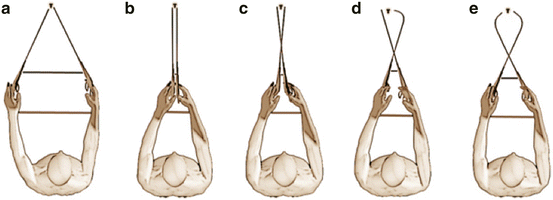, Jason M. Saber2 and Angie A. Saber3
(1)
The Brooklyn Hospital Center, Weill Cornell Medical College, New York, NY, USA
(2)
Pace University, New York, NY, USA
(3)
Rutgers University, New Brunswick, NJ, USA
38.1 Introduction
38.3.2 Conflict of Instruments
38.3.4 Umbilical Recession
38.3.5 Retraction of Large Liver
38.5 Comment
Abstract
There is a growing trend towards surgical techniques that minimize abdominal wall trauma. This will expand the benefits of traditional laparoscopic surgery with less pain, less scarring, less injury to tissues, shorter hospital stay, quicker return to normal physical activities, and better cosmetic outcome. This facilitates the development of a new concept: reduced port laparoscopic surgery (RPLS) with a decrease in either the number of ports or the size of ports, or a combination of both. After our extensive experience with primary bariatric RPLS, we started exploring revisional procedures. In this chapter we will discuss the operative strategy, technical challenges, and step-by-step description of revisional obesity RPLS and transversus abdominus plan block (TAP block).
Keywords
Reduced port laparoscopic surgeryRevisional surgerySleeve gastrectomy38.1 Introduction
There is a growing trend towards surgical techniques that minimize abdominal wall trauma. This will expand the benefits of traditional laparoscopic surgery with less pain, less scarring, less injury to tissues, shorter hospital stay, quicker return to normal physical activities, and better cosmetic outcome.
This facilitates the development of a new concept: reduced port laparoscopic surgery (RPLS) with a decrease in either the number of ports or the size of ports, or a combination of both. The application of this approach has expanded to bariatric surgery. Since our initial description of the single-incision laparoscopic surgery (SLS) sleeve gastrectomy (SG) in 2008 [1], we have applied the same principle to a wide variety of both bariatric and non-bariatric procedures [1–6]. After our extensive experience with RPL primary bariatric RPLS, we started exploring revisional procedures, mainly the revision of the adjustable gastric band (AGB) to SG. In this chapter we will discuss the technical challenges and step-by-step description of revisional obesity RPLS.
38.2 Operative Strategy and Technical Considerations
The feasibility of RPLS is enhanced when tailored according to each patient’s body habitus. In patients with a relatively low body mass index (BMI), peripheral obesity, a small liver, and a short umbilicus–xiphoid distance, we proceeded with transumbilical SLS. In addition to the cosmetic advantages of a hidden intraumbilical single incision, the umbilicus provides a safe zone for abdominal access, while minimizing the torque effect of an obese patient’s thick abdominal wall.
38.3 Technical and Physical Challenges in SLS Approach
38.3.1 Lost Triangulation and Trocar Placement Strategy
Achieving adequate triangulation is a basic principle of traditional laparoscopic surgery.
Trocars can be directed from multiple points of entry, guiding instruments towards the target organ, where adequate manipulation can be achieved (Fig. 38.1a).


Fig. 38.1
Conflict of instrumentation and triangulation in single incision laparoscopic surgery and trocar reduction. With Permission from [6]
Operating through a single incision with only rigid instruments would be challenging, because the surgeon would either implement a parallel positioning of instruments (Fig. 38.1b) or a ‘crossing’ arrangement (Fig. 38.1c). In the parallel technique, both instruments emerge through the umbilicus; thus, controlling both instruments outside the abdomen would pose a challenge because the surgeon’s hands would be at such close proximity. On the other hand, in the crossing arrangement, there would be a considerably more comfortable range of movement on the outside; however, on the inside, the left hand controls the right instrument, and vice versa, posing a challenge for first-time SLS adopters. As the overall flexibility of the instruments increases, triangulation issues can be overcome without sacrificing external maneuverability.
Flexible instruments have articulating shafts, steering the tip of the instrument toward the target organ and restoring lost triangulation. Thus, combining flexible and rigid instruments has resulted in a more comfortable configuration (Fig. 38.1d, e), increasing maneuverability and the feasibility of advanced surgical procedures using SLS. Recently, curved laparoscopic instruments have been introduced to the field of SLS to restore triangulation and minimize fighting between instruments and laparoscope.
38.3.2 Conflict of Instruments
Multiple instruments inserted at close proximity through a common port of entry produce an undesirable limitation of movement both inside and outside. Many advanced procedures involve switching instruments more often, potentially compromising the pneumoperitoneum. These challenges have led to the development of multi-channel ports to avoid the clinching of laparoscopic instruments diverting from a common point.
Stay updated, free articles. Join our Telegram channel

Full access? Get Clinical Tree








